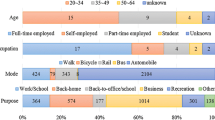Abstract
This paper presents two methods to extract stops and trips from GPS traces: the first one focuses on periods of non-movement (stops) and the second one tries to identify the longest periods of movement (trips). A stop corresponds to a location where the individual halts with the intention to perform an activity. In order to assert the quality of both methods, the results are compared to cases where the stops and trips are known by other means. First a set of traces was used for which the stops were identified by the traveler by means of a visual tool aimed at alignment of manually reported periods in the diary to automatically recorded GPS coordinates. Second, a set of synthetic traces was used. Several quality indicators are presented; they have been evaluated using sensitivity analysis in order to determine the optimal values for the detector’s configuration settings. Person traces (as opposed to car traces) were used. Individual specific behavior seems to have a large effect on the optimal values for threshold settings used in both the TRIP and STOP detector algorithms. Accurate detection of stops and trips in GPS traces is vital to prompted recall surveys because those surveys can extend over several weeks. Inaccurate stop detection requires frequent corrections by the respondent and can cause them to quit.













Similar content being viewed by others
References
Alvares LO, Bogorny V, Kuijpers B, de Macedo JAF, Moelans B, Vaisman A (2007) A model for enriching trajectories with semantic geographical information. In: Proceedings of the 15th annual ACM international symposium on Advances in geographic information systems, GIS ’07. ACM, New York, pp 22:1–22:8. doi:10.1145/1341012.1341041
Bellemans T, Kochan B, Janssens D, Wets G, Arentze T, Timmermans H (2010) Implementation framework and development trajectory of FEATHERS activity-based simulation platform. Transp Res Rec 2175:111–119
Bohte W, Maat K (2009) Deriving and validating trip purposes and travel modes for multi-day gps-based travel surveys: a large-scale application in the Netherlands. Transp Res Part C Emerg Technol 17(3):285–297. doi:10.1016/j.trc.2008.11.004
Chung EH, Shalaby A (2005) A trip reconstruction tool for gps-based personal travel surveys. Transp Plan Technol 28(5):381–401. doi:10.1080/03081060500322599
Cich G, Knapen L, Bellemans T, Janssens D, Wets G (2015) TRIP/STOP detection in GPS traces to feed prompted recall survey. Proc Comput Sci 52:262–269. doi:10.1016/j.procs.2015.05.074. In: The 6th International Conference on Ambient Systems, Networks and Technologies (ANT-2015), the 5th International Conference on Sustainable Energy Information Technology (SEIT-2015)
Du J, Aultman-Hall L (2007) Increasing the accuracy of trip rate information from passive multi-day gps travel datasets: automatic trip end identification issues. Transp Res Part A Policy Pract 41(3):220–232. doi:10.1016/j.tra.2006.05.001
Furletti B, Cintia P, Renso C, Spinsanti L (2013) Inferring human activities from GPS tracks. In: UrbComp 13 Proceedings of the second ACM SIGKDD international workshop on urban computing, ACM, Chicago
Guidotti R, Trasarti R, Nanni M (2015) TOSCA: two-steps clustering algorithm for personal locations detection. In: 23rd ACM SIGSPATIAL, ACM, Seattle. doi:10.1145/2820783.2820818
Knapen L, Bellemans T, Janssens D, Wets G (2014) Canonic route splitting. Diepenbeek, Belgium
Li Q, Zheng Y, Xie X, Chen Y, Liu W, Ma Wy (2008) Mining user similarity based on location history. In: Proceedings of the 16th ACM SIGSPATIAL international conference on Advances in geographic information systems—GIS ’08. ACM Press, New York, p 1, doi:10.1145/1463434.1463477
Ma C, Cao J, Yang L, Ma J, He Y (2012) Effective social relationship measurement based on user trajectory analysis. J Ambient Intell Humaniz Comput 29(1):1–16. doi:10.1007/s12652-012-0120-4
Rasmussen TK, Ingvardson JB, Halldrsdttir K, Nielsen OA (2015) Improved methods to deduct trip legs and mode from travel surveys using wearable gps devices: a case study from the greater copenhagen area. Comput Environ Urban Syst 54:301–313. doi:10.1016/j.compenvurbsys.2015.04.001
Raza A, Knapen L, Declercq K, Bellemans T, Janssens D, Wets G (2015) Diary survey quality assessment using GPS traces. Proc Comput Sci 52:600–605. doi:10.1016/j.procs.2015.05.045. In: The 6th International Conference on Ambient Systems, Networks and Technologies (ANT-2015), the 5th International Conference on Sustainable Energy Information Technology (SEIT-2015)
Schönfelder S, Axhausen K, Antille N, Bierlaire M (2002) Exploring the potentials of automatically colected GPS data for travel behaviour analysis: a Swedish data source. Tech. rep., Ecole Polytechnique Fédérale de Lausanne
Schüssler N, Axhausen K (2009) Processing Raw Data from Global Positioning Systems Without Additional Information. Transportation Research Record: Journal of the Transportation Research Board 2105:28–36. doi:10.3141/2105-04
Spinsanti L, Celli F, Renso C (2010) Where you stop is who you are: visited
Stopher P, Prasad C, Zhang J (2010) Can GPS replace conventional travel surveys? Some findings. In: Australasian Transport Research Forum 2010 Proceedings, Canberra
Tsui S, Shalaby A (2006) Enhanced system for link and mode identification for personal travel surveys based on global positioning systems. Transp Res Rec 1972(1):38–45. doi:10.3141/1972-07
Xiao X, Zheng Y, Luo Q, Xie X (2014) Inferring social ties between users with human location history. J Ambient Intell Humaniz Comput 5(1):3–19. doi:10.1007/s12652-012-0117-z
Yan Z (2010) Traj-ARIMA: a spatial-time series model for network-constrained trajectory. San Jose
Yan Z, Spaccapietra S (2009) Towards semantic trajectory data analysis: a conceptual and computational approach. In: VLDB2009 (PhD Workshop)
Author information
Authors and Affiliations
Corresponding author
Rights and permissions
About this article
Cite this article
Cich, G., Knapen, L., Bellemans, T. et al. Threshold settings for TRIP/STOP detection in GPS traces. J Ambient Intell Human Comput 7, 395–413 (2016). https://doi.org/10.1007/s12652-016-0360-9
Received:
Accepted:
Published:
Issue Date:
DOI: https://doi.org/10.1007/s12652-016-0360-9




